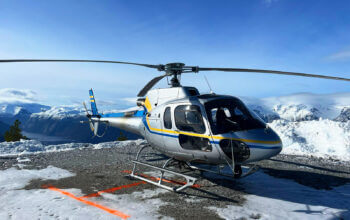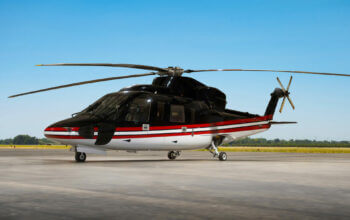Estimated reading time 6 minutes, 49 seconds.
Boeing has commenced production of the new T-7A Red Hawk advanced jet training aircraft for the U.S. Air Force at its facilities in St. Louis, Missouri. The forward fuselage of a Static Test Article (STA) is now 90 percent complete, and the first Engineering and Manufacturing Development (EMD) aircraft will follow.
“We are now squarely in the production phase of the program,” Chuck Dabundo, vice president and program manager for the T-7, told reporters on Feb. 23, 2021. He says Boeing completed its Critical Design Review for the Red Hawk last summer, and that the company had been working on the STA forward fuselage for “the past month or so” and it is about 90 percent complete. It will be mated to the aft fuselage, which is manufactured by Saab; once complete, Boeing engineers will “subject it to representative flight loads” ahead of the flight-test portion of the program.

Saab is responsible for design and build of the aft section of the T-7, and Dabundo called the level of collaboration with the Swedish company on the program “phenomenal.” Boeing and Saab are building and delivering five EMD T-7s in addition to an existing pair of Production Representative Jets (PRJs) that have been used for initial flight-trials. Boeing is also building seven simulators under an initial $813-million contract with the USAF. Boeing says the STA will be complete in “a couple of months,” and that it features a “significant amount of instrumentation” that will allow it to be compared against the digital modelling and prove out the service life goal of 8,000 flight hours.
The Red Hawk has been designed using 3D model-based definition and data management systems, with digital engineering and design playing a key role in Boeing’s ability to field a clean-sheet design to exactly meet USAF requirements. “By creating aircraft and systems along a digital thread, we can accelerate build times and increase quality and affordability for our customers in a way that has never been done before,” commented Shelley Lavender, Boeing senior vice president of Strike, Surveillance and Mobility. “The build process leverages full-size determinant assembly, which allows technicians to build the aircraft with minimal tooling and drilling during the assembly process. The digital process accounts for a 75 percent increase in first-time quality,” added Dabundo.
In September 2018, the USAF awarded Boeing a $9.2-billion contract to supply 351 T-7As and 46 associated ground-based training simulators. Dabundo says Boeing will build the EMD aircraft “throughout this year” to be ready late this year/early next year to commence the joint Boeing-USAF flight-test program, which will run out of St. Louis and Edwards Air Force Base, California. Explaining the flight-test plan, Dabundo said that it is split into two phases; the initial phase has used the pair of PRJs that Boeing built for the T-X competition, the second will use the five EMD jets. The PRJs will continue being used throughout 2021 in parallel with the buildup of the EMD fleet, and one of the aircraft is expected to move to Edwards this summer to perform some local testing. Beyond 2021, the PRJs will likely be retained by Boeing for development and demonstration use.
Boeing plans to start delivering the first aircraft to the USAF at Joint Base San Antonio-Randolph, Texas, from 2023 to commence initial instructor pilot training. This will lead to Initial Operating Capability (IOC) in 2024, which is defined as being a “fully fitted-out squadron of aircraft and training devices.” Dabundo says Boeing expects for T-7 production to run “over the next couple of decades,” starting slow at approximately one aircraft per month and ramping up to four to five aircraft per month at full rate.

Commenting on new business opportunities for the T-7, Dabundo said: “We’ve talked to a number of domestic and international folks that are interested in T-7A or variants of the T-7A that have maybe some tactical capabilities, and there’s been a lot of interest so far.” The USAF and a number of other operators are interested in potential adversary air/light fighter/light attack derivatives of the Red Hawk in addition to the baseline trainer variant.
Dabundo also acknowledged that Boeing has been in talks with the U.S. Navy regarding its Undergraduate Jet Training System (UJTS) program that was launched in May 2020. This calls for a new land-based jet trainer to replace the T-45 Goshawk by 2028. “We have been in discussion with the Navy about a couple of different variants of the T-7,” he said, which acknowledges that the Navy is also looking at possible spin-off adversary use for its new aircraft, as well as a companion trainer role to help reduce the burden on high-end fighter aircraft in fleet squadrons.
Although the U.S. Navy has issued a request for information, there is no program of record right now. Dabundo added that in addition to the USAF, he is “hopeful that we will be able to play a role in the Navy’s training systems as well.”








